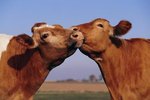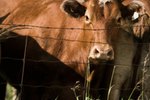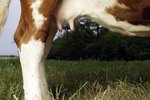The difference between a heifer bull and a herd bull is how they are used. A heifer bull is bred to heifers and a herd bull is mated with mature cows. Heifers are female cattle that are one year of age or older and have not had a calf. Most producers breed heifers to calve at two years of age.
Heifer Bull Definition
Heifers are normally bred soon after reaching puberty, so their first calves are born before they are fully developed and mature. This early breeding can cause calving difficulty if heifers are not properly managed. The best way to significantly reduce calving problems is to breed heifers to bulls genetically equipped for producing low-birth-weight calves. Bulls with these genetics are advertised and sold as heifer bulls. Even though they were bred as heifer bulls, they are often used successfully for breeding older cows as well.
Heifer Bull Selection
The best tool for selecting good heifer bulls is their expected progeny differences (EPDs) on birth weights. EPDs evaluate an animal's genetics and gives producers reliable expectations for a bull's performance. Selection criteria using EPDs varies with cattle breed. A recommended birth weight EPD for Angus heifer bulls is 2.5 or less. This means that calves can be expected to weigh 2.5 times more than calves produced by a bull with a zero birth weight EPD. The recommended birth weight EPDs for Limousine heifer bulls is -0.1 or less.
Calving Ease
Calving ease is an additional EPD used to evaluate heifer bulls and is closely associated with birth weight. Many producers use calving ease EPDs rather than birth weight evaluations for selecting heifer bulls. They feel that calving ease is the most reliable trait for avoiding heifer calving problems. A recommended calving ease EPD for Limousine cattle is 13 or greater. EPDs for other breeds can be obtained annually from the respective breed associations.
Herd Bull
A herd bull is expected to breed 30 to 40 cows two-years-old or older. Calves are normally used as replacement heifers or sold as feeder calves. To produce these types of calves, a herd bull's genetics should enhance early puberty, longevity, moderate mature size and milking ability to match the ranch's forage production capabilities. High docility EPDs are important for maintaining good herd temperament.
References
Photo Credits
-
Jupiterimages/Photos.com/Getty Images





